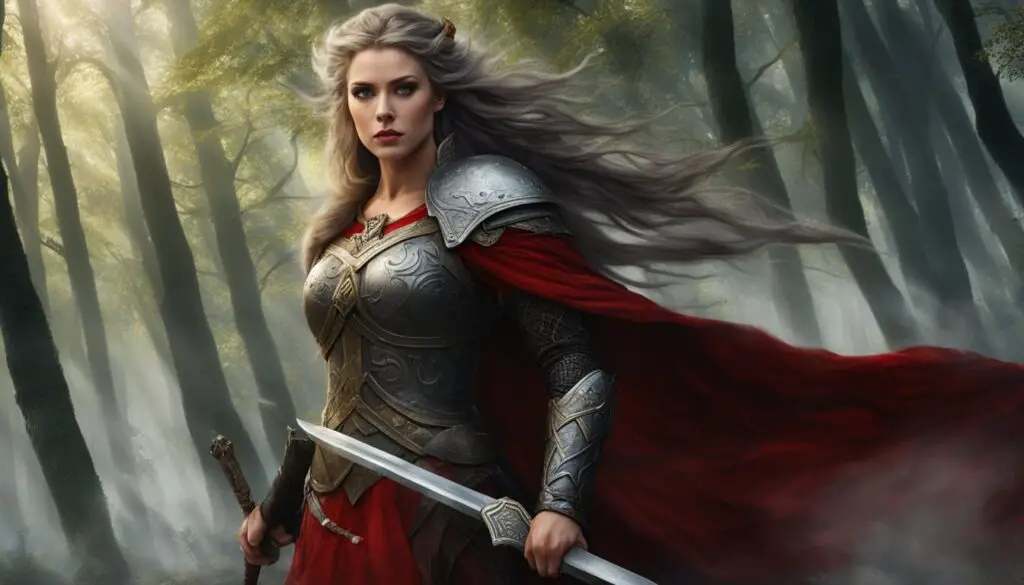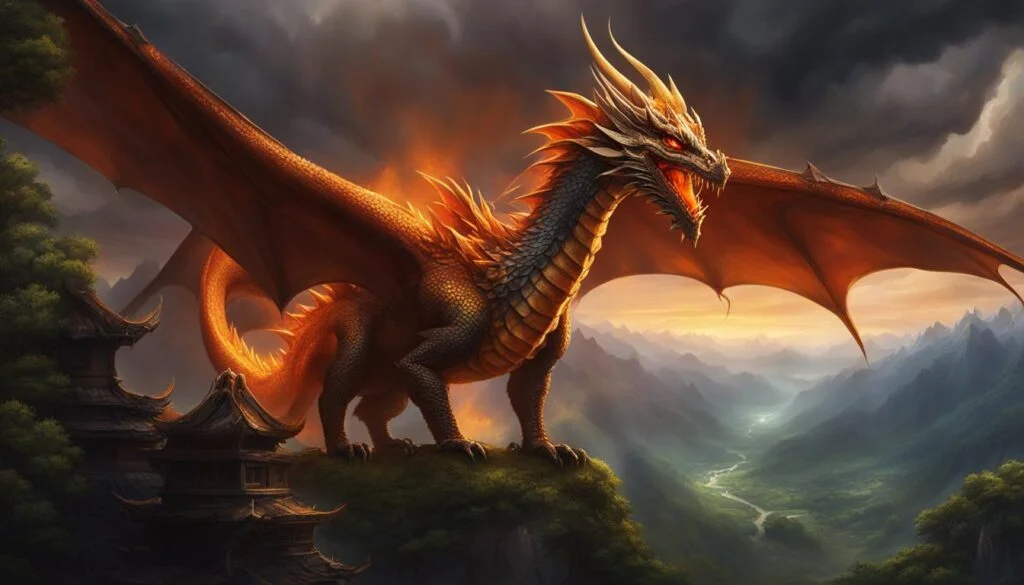In Norse mythology, Freya is a powerful and significant goddess, revered for her associations with love, war, beauty, and fertility. She is also known for her magical abilities and her connection to the Afterlife. Let’s delve into the fascinating world of Freya and uncover the mysteries surrounding this enchanting figure.
Key Takeaways:
- Freya is a prominent goddess in Norse mythology, known for her roles in love and war.
- She possesses magical powers and practices seidr, a form of ancient Norse magic.
- Freya’s name translates to “lady” or “mistress” in Old Norse.
- She is associated with the Brisingamen necklace, a symbol of her power and beauty.
- Freya is the daughter of Njord, god of the sea, and is connected to Odin, the chief god of the Aesir.
The Goddess of Love and War
Freya, the Norse goddess of love and war, encompasses both the passionate and gentle aspects of love, as well as the fierce and strategic nature of war. As the goddess of love, she is closely associated with beauty, passion, desire, and fertility. Freya’s captivating beauty and irresistible charm make her an embodiment of love’s enchanting allure.
However, Freya’s divine influence extends beyond matters of the heart. With her immense power, she also governs over the realm of war. Known as the goddess of war, Freya possesses a formidable and strategic mindset that complements her nurturing love. She is an inspiration for bravery and valor on the battlefield, guiding warriors with her wisdom and guile.
Freya’s role encompasses more than just love and war. She is also a revered figure in the afterlife, presiding over Folkvang, the Norse afterworld. As the divine volva, she ensures the peaceful transition of souls, providing solace and guidance to those who have passed.
Furthermore, Freya is hailed as the bringer of seidr, an ancient form of Norse magic. She introduced this mystical practice to both gods and humans, solidifying her position as a revered figure in ancient Norse culture.
Freya’s embodiment of both love and war showcases the intricacies of her character and the multiplicity of her powers. She beautifully balances the tender and fierce aspects of her domain, making her a truly remarkable and influential goddess in Norse mythology.
The Origin and Name of Freya
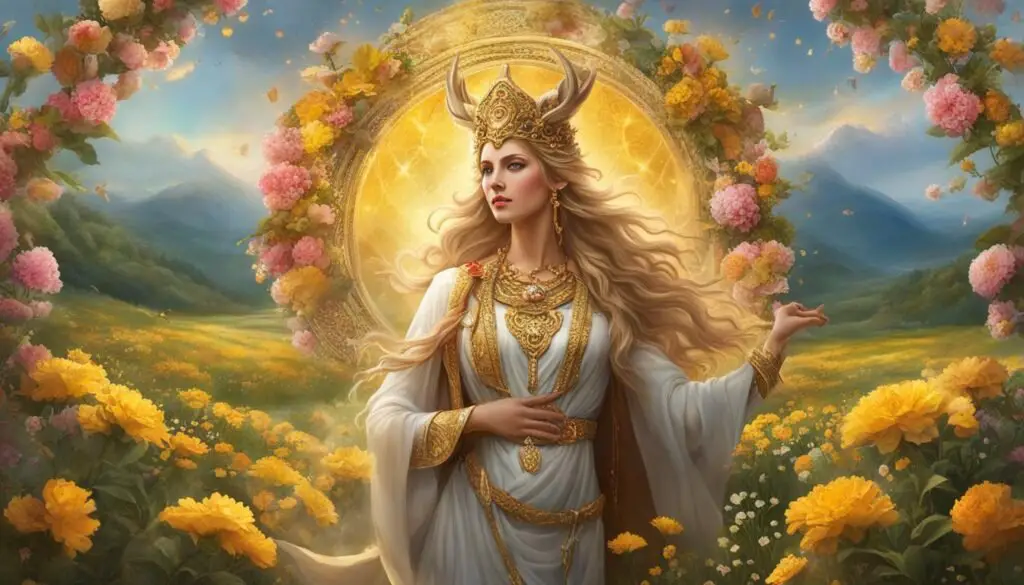
The name Freya comes from the Old Norse word “freyja,” which means “lady” or “mistress.”
It is believed that Freya originated from a more ancient Germanic deity called Frija and was later divided into two separate goddesses, Freya and Frigg. Freya is associated with fertility, and her role as a fertility goddess is closely tied to her connection with love, beauty, and sexuality.
She is also associated with the Norse afterworld, Folkvang, where she receives half of the warriors who died in battle.
Freya’s connection to fertility is a central aspect of her mythology. She is believed to bring abundance and prosperity to both humans and gods, overseeing the growth of crops, the fertility of animals, and the conception of children.
Her role as a fertility goddess aligns with her association with love, beauty, and sexuality. Freya is revered for her ability to embody and empower these aspects of life, inspiring desire, passion, and ultimately, the continuation of existence.
Furthermore, Freya’s association with fertility extends to her role as a goddess of the afterlife. In Folkvang, she welcomes half of the fallen warriors, ensuring the perpetuation of life in the spiritual realm.
Key Points:
- Freya’s name means “lady” or “mistress” in Old Norse.
- She originated from an ancient Germanic deity called Frija.
- Freya and Frigg were later separated into two distinct goddesses.
- Freya is closely associated with fertility, love, beauty, and sexuality.
- She receives fallen warriors in the Norse afterworld, Folkvang.
Freya’s Family and Relationships
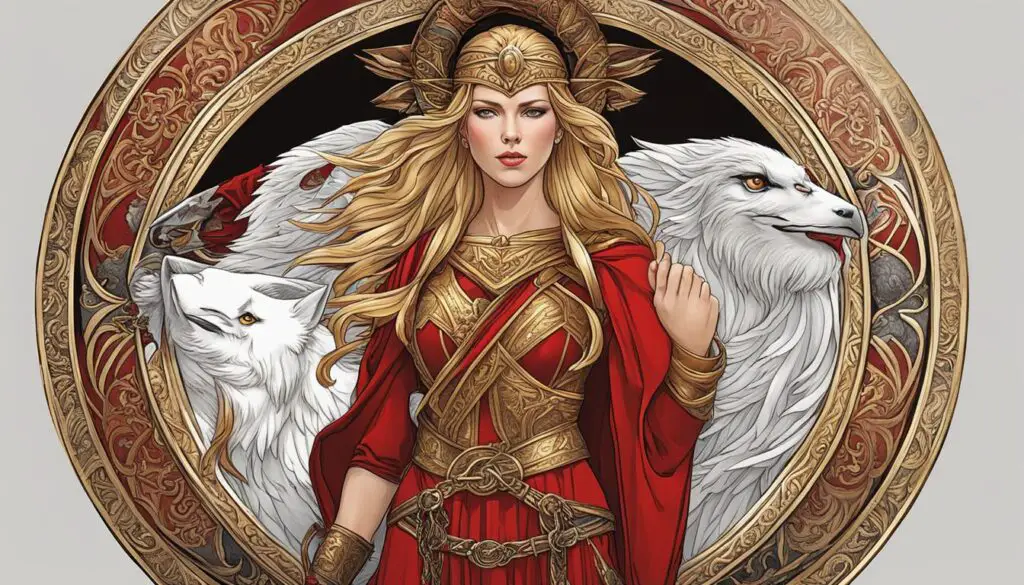
Freya, the Norse goddess of beauty, is believed to have intricate ties within the divine realm. She is the daughter of Njord, the god of the sea, and is often portrayed as having a twin brother named Freyr. Additionally, Freya is associated with Odin, the chief god of the Aesir, and is regarded as his wife or consort.
Legends and myths surrounding Freya’s relationships suggest a complex love life that may have included moments of unfaithfulness to Odin. Despite these complexities, Freya retains her significance as a powerful goddess of beauty and allure.
Depictions of Freya commonly feature her traveling in a chariot pulled by two majestic cats named Bygul and Tregul. This enchanting symbol adds to her mystique and highlights her connection with the animal kingdom.
Another prominent symbol associated with Freya is the Brisingamen necklace, which signifies her power and beauty. This mythical and precious jewel serves as a testament to her status as the goddess of beauty.
Freya’s Powers and Role in Battle

Freya, the Norse goddess of love and war, possesses immense power and plays a significant role in battles and conflicts. As the embodiment of love, she wields the ability to influence the lives of both humans and gods, her divine presence felt in every aspect of existence.
Associated with the practice of seidr, a powerful form of magic, Freya can predict and shape the future. This mystical ability allows her to navigate the intricacies of love and war with unparalleled foresight.
Freya is renowned for leading the Valkyries, divine shieldmaidens of Odin, and it is she who selects the bravest warriors to join Odin’s mighty army in Valhalla. Her discerning eye ensures that only the most valiant heroes are honored with a place in the grand hall of the fallen.
While Freya’s role as a goddess of love is well-established, her reputation as a fearsome warrior is equally formidable. She fights alongside her chosen warriors, embodying the fierce strength required to triumph in battle.
As you delve deeper into the realm of Norse mythology, you will discover the awe-inspiring might and multifaceted nature of Freya, the goddess who commands both love and war.
The Powers of Freya:
- Ability to influence both humans and gods
- Prediction and shaping of the future through seidr
- Leadership of the Valkyries in selecting warriors for Valhalla
- Fierce combat skills and prowess in battle
Through her unique blend of love and war, Freya emerges as a transcendent figure in Norse mythology. Explore the depths of her powers and the intricacies of her role in battle, for her story holds countless wonders waiting to be uncovered.
Freya’s Unique Accessories
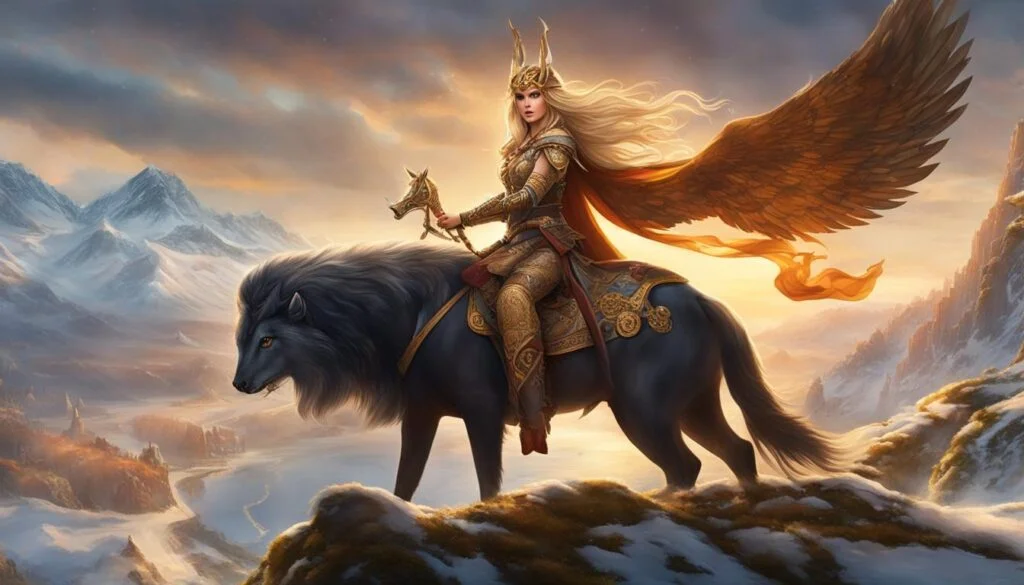
Freya, the Norse goddess of love and war, is renowned for her distinct accessories, which serve as powerful symbols of her strength and beauty.
One of the most iconic pieces associated with Freya is the Brisingamen necklace. This mythical and precious jewel is believed to grant her unparalleled power over love and beauty. Wearing this necklace, Freya embodies her role as the goddess of love and beauty, radiating her enchanting presence throughout the realms.
Another remarkable accessory of Freya is her magical cloak made of falcon feathers. This cloak allows her to transform into a majestic falcon, the embodiment of her animal spirit. With this ability, Freya soars freely across the skies, embodying grace, agility, and soaring above all limitations.
Freya’s connection with the animal world is further represented by her magnificent chariot, which is dramatically pulled by two majestic male cats. These feline companions symbolize her affinity and influence over the animal kingdom, highlighting her inherent nature as a guardian and protector.
Together, these unique accessories enhance Freya’s status as an awe-inspiring deity, exemplifying her power, grace, and influence over love, beauty, and nature itself.
Conclusion
Freya, the Norse goddess of love and war, holds a prominent place in Norse mythology. Her multifaceted nature encompasses both the tender and fierce dimensions of love, alongside her strategic prowess in battle. Associated with beauty, fertility, and the practice of seidr, a powerful form of magic, Freya stands as a symbol of divine power and influence. Her significance extends beyond mortal boundaries, captivating the hearts of both humans and gods.
Renowned for her role in the afterlife, Freya presides over the Norse afterworld known as Folkvang. She holds a unique assortment of accessories, including the mythical Brisingamen necklace, which embodies her authority over love and beauty. Another striking emblem is her cloak made of falcon feathers, allowing her to embody the spirit of a falcon. Moreover, Freya’s iconic chariot, drawn by two male cats, speaks to her remarkable connection to the animal realm.
In the vast tapestry of Norse mythology, Freya’s influence encompasses realms ranging from love and war to beauty and magic. Her captivating persona as the goddess of love and war resonates with the gentle and fierce aspects of human existence. With her unwavering power and allure, Freya continues to leave an indelible mark as one of the most revered deities in Norse mythology.
FAQ
Who is Freya in Norse mythology?
Freya is one of the most important and powerful goddesses in Norse mythology. She is associated with love, war, beauty, and fertility.
What are some key attributes of Freya?
Freya is primarily known as the goddess of love and war. She embodies both the passionate and gentle aspects of love, as well as the fierce and strategic nature of war. She is also associated with beauty, passion, desire, and fertility.
What is the origin and meaning of the name Freya?
The name Freya comes from the Old Norse word “freyja,” which means “lady” or “mistress.” It is believed that Freya originated from a more ancient Germanic deity called Frija and was later divided into two separate goddesses, Freya and Frigg.
Who are Freya’s family members and what are her relationships?
Freya is the daughter of Njord, the god of the sea, and is believed to have a twin brother named Freyr. She is associated with Odin, the chief god of the Aesir, and is considered to be his wife or consort. Some myths suggest that Freya had a complicated love life and was unfaithful to Odin.
What are Freya’s powers and her role in battle?
Freya is one of the most powerful goddesses in Norse mythology. She has the ability to influence the lives of both humans and gods. She is associated with the practice of seidr, a form of magic that involves predicting and shaping the future. Freya is also known for her role in battle, leading the Valkyries and choosing the bravest warriors to join Odin’s army in Valhalla.
What are some unique accessories associated with Freya?
Freya is often depicted wearing the Brisingamen necklace, a mythical and precious jewel that grants her power over love. She is also depicted with a magical cloak made of falcon feathers, allowing her to transform into a falcon. Additionally, Freya rides a chariot pulled by two male cats, representing her connection with the animal world.
In summary, what are the key aspects of Freya?
Freya is a complex and fascinating figure in Norse mythology. She is the goddess of love, war, beauty, and fertility. Her power and influence extend to both humans and gods, making her one of the most important deities in Norse mythology.


